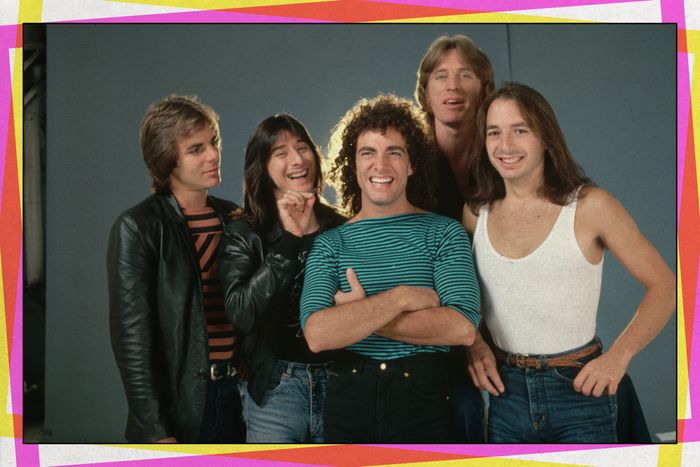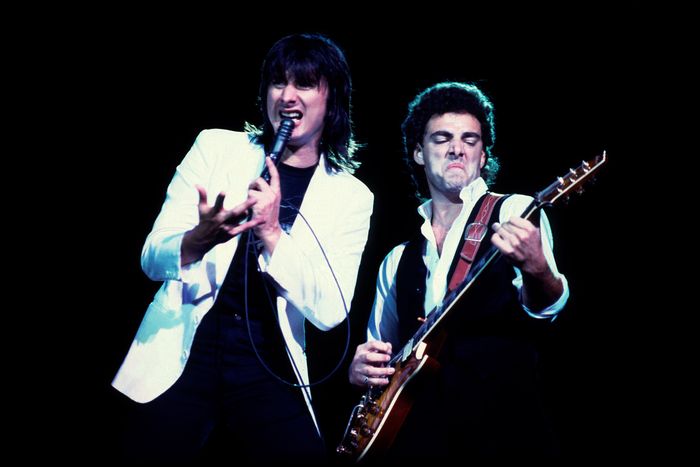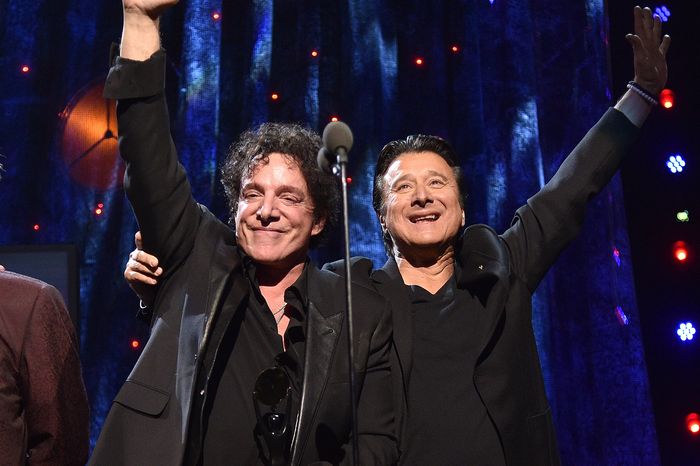
The shadow of “Don’t Stop Believin’” looms large, quite literally, over the “funky little office” in Neal Schon’s home. We’re just starting our video call in the lead-up to Freedom, Journey’s newest album in more than a decade, but there are two pieces of wall paraphernalia that require further explanation (for this writer’s fuzzy eyes, anyway): There’s a framed Escape record to commemorate its diamond status and … is that a floating green orb? Spotify’s logo? Ah, yes, it’s a poster for the billion streams “Don’t Stop Believin’” has commanded over the years, and it looks mighty fantastic floating over Schon’s head. “I usually don’t put anything up on my walls in the house that represent my accomplishments because I look at my career like you’re only as good as your last day, so that way you can keep moving forward and not rest on your laurels,” he explains. “But this is my office, and I realized it was kind of bland, so I put those behind me.”
Freedom, out July 8, encapsulates the scorching spirit that listeners have always loved about Journey, whose wheels keep churning out stadium-ready anthems and ballads after nearly five decades together. Sure, there might be a sonic Ship of Theseus comparison to make — Schon, on lead guitar, is the sole member who has remained since the band’s formation in 1973 — but we got the likes of “Any Way You Want It,” “Faithfully,” “Separate Ways,” and the song about streetlights, peopleeeEEEeeeeEEEE, over that time period, so let’s call it even. Steve Perry’s vocal range should probably be studied for scientific reasons; so should Jonathan Cain’s fingers, for how nimbly they go between keyboards and rhythm guitar. (To give you a sense of the ship’s size, that trio, as well as bassist Ross Valery, drummer Aynsley Dunbar, vocalist Gregg Rolie, and drummer Steve Smith were all inducted into the Rock Hall of Fame for their Journey tenures. Yeah, two drummers!)
Despite Schon’s forward-looking mentality, he was happy to be our latest Superlatives subject; we talked for well over an hour about Journey’s evolution, melodies, and the cringeworthy spectacle of one music video.
Best song
That’s a tough question. I’d probably go with a song that has more of a sentimental feel to me because I wrote it with my father. “Mother, Father” is very orchestral and very musical compared to our more pop-oriented rock songs. With “Mother, Father,” I had these classical chord changes that I came up with, and I wrote the whole song musically. And then my father, while he was living, wrote really interesting notes for it on the piano. I showed him the chord changes, and he came up with the interlude that the guitar and piano play. It pulled the whole song together. I like the sentiment of what Steve and Jonathan wrote lyrically about the song. I usually don’t come from that area. There’s a few songs that I’ve written choruses on, but I don’t really consider myself a lyricist. So I felt that, where they came from — about family in general, disjointed families, and how they fight to stay together — it’s something real that everybody deals with. I thought it fit perfectly for the music. I also like our deeper musical cuts that are a bit more involved musically. I tend to like the more orchestral songs like “Still They Ride,” “Mother, Father,” or “Winds of March.”
Heaviest song
“You’re on Your Own.” That’s heavy. Or songs like “Of a Lifetime” and “Kohoutek.” That early material was very much more progressive and heavier, in a sense. I feel people are misled by our albums a lot — like, they haven’t seen us live. Our band tends to be heavier live than the albums are. So “Separate Ways” is heavy in another way. It sounds like Motown or like it could be a Four Tops song, for Christ’s sake. But then you put the electricity of the guitar and the blues mixed with the melody, and it becomes a lot heavier. I don’t think we have anything that’s heavy, heavy, like metal. We’ve never tapped into that type of music.
When Jonathan came into the band, there was immediately a push to go bigger in an organic way. This goes back to my point of people maybe not being familiar with us live or the heavier side of the band: If you only listen to AM radio, you’re going to consider us soft rock. I don’t consider us soft rock. We have a broad spectrum. We show our dexterity and diversity on all of our albums. We’ve traveled the spectrum musically from A to Z. There’s still a lot of territory we can go in, but I think we made a very good album with Freedom, which helps keep us relevant and up to speed, yet also influencing the younger audience to come with us.
There are kids that come to see us who look like 16 or 17 at most. They know all the songs and are completely open-minded to the most outside things we’re going to lay on them. It reminds me of when I would go see my favorite bands as a kid. I would go and see Jimi Hendrix, Led Zeppelin, the Who, or Jeff Beck with Rod Stewart. They were all up the wall compared to what was on the radio. The entire audience loved all that music, but they would sit down at concerts in that era! So I would sit on the floor and observe and listen. Then at the end of the night, we would all get up and go nuts. I believe that the musical statement you make, people don’t have to go nuts after every song per se. It’s an overall experience and how you take people on it. I think the more you lay on them, the better.
Song you experience the most joy performing live
It wasn’t something that was a huge single: “Lights.” A simple, bluesy stroll song. The second song I ever wrote with Steve Perry was “Lights.” It’s become a freakin’ anthem. More people in the audience light up and sing that song louder than anything else. It used to be lighters, but now it’s cell phones. It wasn’t pushed out there by the label; it just happened in an organic way. It had a different feel to it when Steve first showed it to me. It was more old-school blues, but when I put that rolling rhythm around it — a Curtis Mayfield– or Jimi Hendrix–type thing — it took on a whole different perspective than what Steve started with. He had the melody; he had the bass. I was like, “What if we did this?” Then I wrote the bridge. A lot of nights, I can’t even hear the band onstage because of the audience.
Song that’s always evolving, even in 2022
A song that we continually jam on, open up, and switch up a bit is “Wheel in the Sky.” It’s an early song that I wrote with Robert Fleischman. The lyrical content came from a poem that Ross Valory’s ex-wife wrote and handed me on a napkin years ago. She had written down, “Wheels are turning on my mind.” In one of our long station-wagon hikes we did when we were traveling as a band — like nine guys in a station wagon in those days — at one point, everybody had to take a restroom break, and the driver needed a candy bar to wake up. I pulled out the acoustic guitar, sat on the hood of the car, and I banged out that song. I came up with the chorus. Her napkin poem sat in my mind and I came up with “Wheel in the sky keeps on turning, I don’t know where I’ll be tomorrow.” I’ve since ripped that song apart and put it back together. I keep reinventing “Wheels,” and it ends up being a big and powerful highlight in our shows. That’s another song that wasn’t a huge hit single but has since become an organic hit within our Journey audience.
Most romantic ballad
It depends on what era you want to go in. There’s a lot of romance. It depends on what type of romance you’re talking about. I think the ones that are obvious picks are “Faithfully” and “Open Arms.” They probably get played more at weddings than any song ever. “Send Her My Love” is very romantic in a different way. I love that song. It has such a great melody and I love that it’s not too radio-friendly. It’s coming from a deeper place. “Faithfully,” though, is a beautiful song. Jonathan hit it out of the park with that one. We were in the studio and Mike Stone, our producer at the time, said, “I think you guys are missing a really big power ballad.” We were doing a lot of experimenting for that album — trying to get a bit heavier and do some things that we hadn’t done before.
With “Faithfully,” it started off more off the wall. It was like a Police song twisted up sideways. It had an interesting drum beat. Jonathan came in the next day and he played this song for us and it didn’t sound anything like what we made it sound like. It sounded like a beautiful country ballad. I couldn’t quite imagine what it would sound like with us playing it. I couldn’t imagine “Open Arms,” either. I fought hard on “Open Arms.” At the time I was not getting it and didn’t want to get it. Now I enjoy it. [Laughs.] But when he showed us “Faithfully,” I wrote out a little chart because I don’t really read music. We ran through the song once, and I just free-formed my way through it. Steve was not singing. At the time, there was no singing and we were just trying to get the basic track done. In those days, I pretty much would play off the cuff — the first thing I’m hearing in my head, this is what I’m hearing, whether it’s wrong or right. I played one guitar through the whole song, that’s it. What you hear on that track is the second take we did.
I came up with a line that sounds like a French horn. It’s like me singing the Who with John Entwistle playing the French horn. I like the sound of that instrument. I had attuned my ear to symphonic music and classical music when I was younger. I played oboe in school. It was a great way to pass the time because I was not into school at all. I liked music and I liked art. I was always in the art room or playing something. So that kind of came out and I improvised my “Faithfully” parts through the end, not knowing what the vocals were going to do. I couldn’t decipher how someone like Steve would interpret it. So it was interesting how it came about when we cut the song. We all did it together. No fixing. What I do recall is that Steve wanted everybody to leave the studio — he wanted to have his time with the song to experiment with it and put himself in it. Jonathan wanted to be in the studio and Steve refused. He said, “No, you got to leave.” So coming back into the studio and hearing what Steve did, I was like, “Oh my God! Amazing.”
Guitar work that’s your melodic masterpiece
I try to make most of my solos, especially with the more radio-oriented songs. They’re extensions of the vocals. If there’s a guitar solo, it needs to convey a strong melody. You learned to love melody. I mean, the Beatles taught us all about that a long time ago. I still hear the sound that Roy Thomas Baker got when he mic’d up my old Marshall with a Fender Stratocaster on “Lights.” He had me set up in a closet and the amp was cranked to ten, and the mic was sitting in the back of the very echoey room. So “Lights” would be a masterpiece. “Who’s Crying Now,” probably another.
Funny enough, I absolutely hated my “Who’s Crying Now” guitar work when I did it at first. It was true frustration with that song because it didn’t come out immediately. It was another new type of song that Jonathan had brought in and I didn’t know what to do with it. I was trying to be more demanding with myself. We’d get off to a good start, and then I’d have nowhere to go. It was just kind of plotting along and doing this pop thing. So the producers and the whole band were getting frustrated with me because I wasn’t giving up. I probably did about, I don’t know, 15 takes, and it was going nowhere slow. Usually the best stuff comes out of me on the first or second take and then it goes downhill. When I’m not thinking, it comes out. When I start thinking, it never comes out. So out of pure frustration, I played the simplest thing, just kind of being like a smart-ass. I was in the studio and I thought, Oh, this will shut them up. And I played it, and I went, “There you go. That’s what you want.” And they go, “It’s fucking perfect.” [Laughs.] Now, the audience loves singing it.
“Don’t Stop Believin’” is also important to me. The chorus is such a crazy arrangement when you think about it. The fact that it’s become this massive hit, this many years later, nobody in the band ever pictured that happening. It didn’t soar that high on the radio when we released it. I remember when I heard it during the final mixes, I told the guys, “I think this song is going to be massive.” The way it’s structured is unusual — it’s not your usual verse, chorus, verse, chorus. It really is so cliché, what they considered a format for radio. The song never got to the fucking chorus until the end! I came up with the “strangers waiting” lyrics and how the arrangement went back to another verse, except the verse doesn’t happen. It does a little symphonic instead. It sounded to me like something that would happen in an orchestra. I sped up the arpeggio and started playing around and realized, Oh, that’s cool. We’re going to leave that and write lyrics around that. That’s how they came up with “She took the midnight train going anywhere.” Because it actually sounded like a train! So it came together like that, and then it came time for a little guitar solo. Nobody had heard the chorus yet, so the obvious thing to do was to play the melody in the chorus. I was going to implant it in their heads before it was even sung.
Guitar solo that doubles as the greatest endurance test
I have no signs of tendinitis. [Laughs.] I play almost every day, even when I’m at home. I play because that’s how things don’t freeze up on you. It’s a muscle; you have to use it. I really don’t practice scales. I don’t know scales; I never wanted to. I play all by ear. What I practice at home is just following the flow of whatever vibe I’m in. There’s a lot of guitar players who watch my social-media videos and they like the fact that they have nothing to do with a song — it’s off the cuff every day. And then you have guitarists who are kind of jazz bros. I love jazz. Some jazz cats can be really snooty though. Someone will be like, “Dude, what are you doing? You’re playing the same chord in every song. Every day you sound the same.” And I go, “B.B. King did the same, ever heard of him?
I fell into that a long time ago. My former manager said to me, “Why are you worried about sounding different on every song and pressing yourself so hard to sound like somebody different? You’re just going to confuse people. People know what you sound like, don’t be afraid of sounding the same every time.” Now I have this style that’s stuck with me, and he was correct. That’s a hard thing to do and I don’t see a lot of younger guitarists doing it. I don’t see a lot of personality. I had B.B., Howlin’ Wolf, Buddy Guy, Albert King, and Michael Bloomfield to look up to. Then I had all of the electric guitars from overseas, like Jimmy Page, Jeff Beck, and Eric Clapton. I listened. You don’t see that kind of voice coming out of people anymore.
That’s where I come from — it’s a natural place and more of an organic blues background. While we were down in this pandemic, I spent time experimenting a lot as a guitarist. I consider myself a real musician. I’m always going to strive to get better and learn more because you never learn everything about any instrument. You never reach the peak, and when you reach the peak, it’s over, man, you’re done. You might as well just go and never try to create any new stuff. I know I can emulate myself. I can play exactly what I did back in 1973. I won in that regard. It’s just embedded in me. So I strive to move to new places all the time because that’s what motivates me with music.
Most endearing Steve Perry memory


We were very, very tight. We’re talking and getting to know each other again — though not trying to get together musically again, but he’s learning who I am now, through a portion of our business that I’m kind of controlling now. I’m talking about a Journey trademark that I’ve obtained, as we’ve never owned our own trademark. All these years, many people lied to us. My wife and I finally got to the bottom of it after investigating for years. We were fought hard by everybody, but we managed to obtain the trademark. So we’re talking about that and figuring out the future of that, but we’re talking.
I have great memories of when Steve and I first met. We hung out all the time, man. We were like brothers. We were crazy. We spent a lot of nights out way too late doing things we shouldn’t be doing. Drinking and whatnot. We overindulged in a lot of stuff. But bottom line, we had a really good time for many, many years. Lots of enduring moments onstage and offstage. He was a really funny guy. I saw a fraction of a moment of it when we got together before the Rock Hall of Fame induction. I managed to get into his room, which was locked down like Fort Knox. We had a good hang in there. I felt like I still knew this guy and we were still really great friends.
I felt good about what was going to partake on the stage. He was always invited to come and perform at the ceremony, but he declined to do anything besides a speech. I understood why. During that induction, when certain individuals went up and took a really long time with their speeches, there are a few pictures that you can find where I’m talking into Steve’s ears and he’s laughing like hell. Some people like to feel like they’re more important because they have to talk longer. Or they feel like they don’t get the attention they need so they want to talk longer. So, that’s my long way of saying that I hope that we can become even better friends in the future.
Rating the “Separate Ways” video from 1 to 10 on the cringe scale
Oh my God! You know what a lot of people don’t understand? This was the very beginning of MTV. Nobody was making $200,000 videos or $500,000 videos or $3 million videos. Some people were paying a million and a half for a music video because they had a movie producer backing them financially. What a freakin’ rip-off. I mean, that’s what it became. But back when we did this, our manager came to us and said, “Look, we need to get a music video. Who should we use?” I suggested the director Wayne Isham. He came in and put together the storyboard. It was going to be in New Orleans, on a pier. Is it terrible? The air guitar and keyboards are cheesy as hell. I give it a 10 on the cringe scale. It’s so silly, man. Journey was not a band that did well with videos that had story lines. “After the Fall” was terrible. “Chain Reaction” was a little more fun. Steve and I were pushing each other around for that one, and I’m in his face. I think the only videos that really worked for Journey were when live concert footage was used. It was like a live performance — showing the audience, showing us onstage.
How The Sopranos’ use of “Don’t Stop Believin’” changed the meaning of the song for you
Well, I don’t think it changed the meaning of what the song is about, which is just to have faith in yourself. That’s the message it’s conveying — it’s an uplifter for people who may be second-guessing themselves in their lives. I absolutely watched The Sopranos during its run. I loved it. I remember getting an email about using the song about six or so months before it aired. They were thinking about using it but didn’t give any context. I honestly didn’t think anything of it. I went, “Oh, that’s nice, whatever. If they use it, great.” I could have never imagined it was going to be the blackout scene in the last episode. It just rocketed the tune to a whole different spectrum. I mean, how could you ever even imagine that? I thought the final scene was amazing. I received a lot of phone calls that week, that’s for sure.
You know what? I kind of interpreted the ending … weirdly, it goes back a long way to a memory I have of Steve and I sitting in a pizza parlor. We were on tour and hadn’t had a song on the radio yet. I remember Steve went back and looked through the jukebox and I’m sitting at the table waiting for a Coke and pizza. He went back and dropped a couple quarters in there and played a couple tunes, and on came “Wheel in the Sky.” We looked at each other and laughed like hell. I remember saying, “I can’t believe this.” We were both jumping up and down. So I looked at that Sopranos scene with that memory in mind because they were sitting at a diner table and had the little diner jukebox there, and Tony Soprano presses it, and the song comes on. I don’t know if Steve had talked to the show’s team about that experience we shared together, but it was very similar to what actually happened with him and me. How beautiful is that?
More From The Superlative Series
- Hans Zimmer on His Most Unusual and Underrated Scores
- The Coolest and Craziest of TLC, According to Chilli
- Kim Deal on Her Coolest and Most Vulnerable Music


